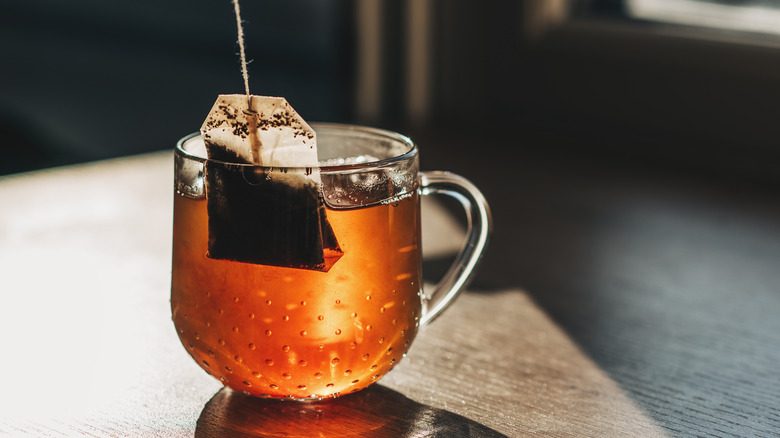Yes, You Can Reuse Tea Bags — But There's A Catch
The average tea drinker in the U.K. goes through about four bags a day — that's nearly 1,500 tea bags tossed in the trash each year. No wonder so many people wonder whether those bags can be stretched further than one use. The answer is yes, but only up to a point.
While tea bags are designed for single use, you can usually get one or two extra steeps before the flavor gives out. After that, your cup will taste more like hot water than tea. How well the tea holds up depends on the type: Black and herbal teas, which need longer steeping times, lose their punch more quickly, while green, oolong, and white teas — with their shorter steeps and coarser textures — tend to stand up better to a second use. Loose-leaf teas typically re-steep better than bagged teas, as the leaves are whole and offer more flavor than the tea leaf "dust" often found in pre-packaged, store-bought tea bags.
If you do plan to reuse a bag, it's important to know how to store it. A used tea bag should stay moist (either submerged in water or kept damp), because once it dries out, it can become a breeding ground for bacteria or mold. Be sure to leave it in cool water, as hot water can over-steep the tea and turn it bitter. For best results, reuse your tea bag within a few hours up to a day before opting for a fresh one.
Make the most out of your used tea bags
Even after you've squeezed out that last bit of flavor in your second cup, a used tea bag still has plenty of life left. For starters, chilled tea bags can double as a quick beauty hack; simply place them under tired eyes to reduce puffiness, or press them against minor sunburns for a soothing effect. Green or black teas are especially effective since their high antioxidants and caffeine levels help calm inflammation.
Around the house, tea bags can be surprisingly handy: Wipe them across mirrors to erase streaks, degrease dirty dishes with tea bags, or even use them to clean bamboo steamers. If you've got plants, your garden will love them, too. Used tea bags can be torn open and sprinkled into soil as a fertilizer, or tossed directly into the compost. Be mindful to only use tea leaves to fertilize acid-loving plants, such as hydrangeas and ferns.
You don't have to leave the kitchen to reuse those tea bags, either. After one or two steeps, the leaves have a subtle flavor perfect for infusing grains like rice or quinoa. Simply drop a bag or two into the pot when cooking your grain, and you'll add a mild, unique flavor to an otherwise standard dish. Using ginger tea or Genmaicha (Japanese green tea mixed with roasted popped brown rice) is a simple way to spice up fried rice, while a lemon-infused black tea adds additional citrus flavor to Chitranna, an Indian lemon rice.


